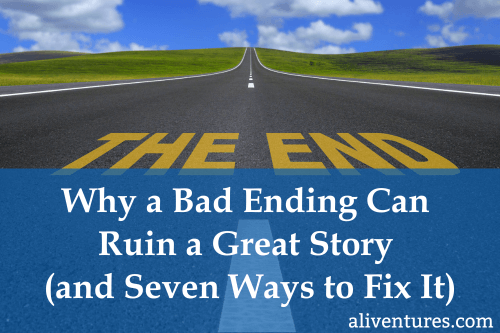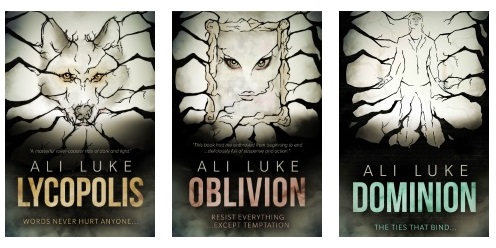Why a Bad Ending Can Ruin a Great Story (and Seven Ways to Fix It)

Have you ever been really into a book, engrossed in the story, waiting to see how it all ends …
… only for the ending to disappoint you?
I’ve read a few books like that.
And the sad thing is, I wouldn’t re-read them, or recommend them to friends. Because if the ending doesn’t land properly, the whole reading experience is just a bit disappointing.
A slow start or a meandering middle are okay. An exasperating ending … that’s a lot harder to let go of.
(The same’s true in life. If you’ve had a day that started promisingly, but ended badly, you probably think of it as a bad day overall.)
When you’re reading a novel, in a way, the ending is the whole point.
Structurally, the ending (the climax and resolution) solve the major problem set in place at the beginning (by the inciting event). If the ending doesn’t resolve things in a satisfactory way, we’re left disappointed.
The ending of your story is also the peak of your protagonist’s character arc. It’s the moment when they’re tested to the full … and when they (hopefully!) triumph. We want their happy ending to feel earned.
If it doesn’t, the story doesn’t feel satisfactorily complete.
So where do endings go wrong … and how can you make sure your ending works?
Note: A “bad ending” isn’t the same thing as an “unhappy ending” or “tragic ending”. Stories can absolutely end unhappily for the main character(s) and that ending can be entirely satisfying.
Six Types of Bad Ending
This isn’t an exhaustive list, but these failed endings are ones that crop up quite often.
#1: Deus Ex Machina Ending
The literary term “Deus Ex Machina” means “God from the Machine”. It was a device used in Greek theatre – usually in tragedies – to resolve the plot by having an actor playing a god descend from above or rise up through a trapdoor.
In modern fiction, you’re unlikely to see plots resolved literally by the gods. But you might get a story with an ending that relies on some sudden force of nature or a random accident.
This is what happens in Jodi Picoult’s My Sister’s Keeper. The main conflict of the plot (Anna doesn’t want to donate a kidney to her sister Kate) is resolved when Anna is killed in a car accident. There’s nothing that paves the way for the accident – it’s just random chance. It makes for an incredibly dramatic, sad ending to the book, and some readers see it as speaking to the fragility/randomness of life … but it’s notable that the film version completely changed the ending.
#2: It Was All a Dream Ending
This ending is more common in short stories than in novels. Typically, the main character is in some inescapable (often slightly bizarre) situation. We’re on the edge of our seats, waiting to see how they’ll get out of it … then they wake up in their bed. It was all a dream.
Like the Greek gods descending onto the stage, the dream ending may have worked once. Alice in Wonderland ends with Alice being woken by her sister: she’s fallen asleep under a tree. It’s still a much-enjoyed children’s classic … but that doesn’t mean it’s an ending that generally will work well for readers today, even in children’s fiction.
#3: Hands-Off Ending
In some stories, there’s a major conflict between the protagonist and the antagonist. We’re expecting a big showdown of some kind, and we’re eager to see the antagonist finally get their comeuppance … only for the resolution to happen in a very hands-off way. There’s no real confrontation, even though the protagonist “wins”.
This happened in a couple of domestic thrillers I’ve read: Behind Closed Doors and Little Face. In Behind Closed Doors, the female protagonist kills her abusive partner (he’s an absolute monster and deserves it!) by drugging him, shoving him down a staircase, and locking him in a basement where he dies of dehydration. With the help of a friend providing an alibi, she gets away with it … but his evil is never exposed to the world.
Logically, it’s a sensible ending: the antagonist is so powerful (and has the police on his side) that an actual fight probably wouldn’t end well for her. But after he’s mistreated the protagonist for the whole book, I really wanted more of a confrontation between them.
Little Face, by Sophie Hannah, is similar. Again, there’s a female protagonist and an abusive male partner … and no confrontation. The mother-in-law, who was pulling the strings – and who turns out to be a murderer – is defeated, but there’s no confrontation that deals with the incredible cruelty (torture, even) from the husband. Both books are gripping thrillers, but they’re let down by their endings.
#4: Overly Abrupt Ending
In some stories, the climax and/or resolution simply don’t get enough space. The ending feels sudden and abrupt, without a real sense of the story being finished. While it’s important not to drag on the resolution for too long – you don’t need to tie up every single loose end – you do need enough time after the climax to close the story.
For me, Ready Player One ends too abruptly. The end of the climax, when Wade gains control of OASIS, is just a few pages from the end of the actual book. There’s hardly any time for a huge plot thread to be resolved (Wade meeting Art3mis for the first time) and there’s no real sense of what the characters’ new “status quo” will be. In part, I think this is because Ernest Cline was paving the way for a sequel, and I still enjoyed and re-read Ready Player One, but I’d have liked just a bit more resolution at the end.
#5: Dragged-Out Ending
This is the flip side of the “overly abrupt” ending. Some authors go too far in wrapping up loose ends, going way beyond the story itself to tell us lots more details. That can often happen in an epilogue.
An epilogue is a final chapter that takes place some time after the main story. Sometimes, it can be effective, letting us know that the characters stayed together long-term, for instance. In others, the epilogue ends up taking too long or covering too much time.
The epilogue to Harry Potter and the Deathly Hallows – taking place 19 years after the battle of Hogwarts – is disliked by many readers, for instance. Some feel the main problem is that the actual ending is too abrupt: they wanted more details on the characters in the immediate aftermath of the war. Others dislike the jarring change in tone between the darkness of the main story and the light, cheerfulness of the rest, or feel it doesn’t leave enough to the reader’s imagination about what happens next.
#6: Cliffhanger Ending
A cliffhanger ending is where you stop the book with a major problem unresolved. This can work if you’re essentially setting up a new problem – the end of The Hunger Games does this well, with Katniss realising that although she’s survived the Games, she’s in a much more dangerous position now due to her defiance of the Capitol.
Where this kind of ending doesn’t work is if you don’t resolve the main conflict of the novel. If we’re expecting some kind of resolution that never happens – because your story really runs across two or more books – then you may end up annoying your readers! For me, Doors of Sleep by Tim Pratt was like this: the reader’s expecting answers, only for a formerly minor character to suddenly appear with a huge revelation and cliffhanger.
Seven Ways to Fix an Ending That Isn’t Working
What if you’ve written an ending that you’re concerned isn’t quite working?
A good first step is to get feedback, if you can – this probably means enlisting beta readers who are happy to read the whole novel, as no one can really tell you if the ending works without knowing everything that’s led up to it.
Whether or not you can get some feedback, here are some key pointers to make your ending work. Remember, the climax of your novel is one of the two scenes that will likely need the most rewriting. It’s absolutely to be expected if you don’t have it right the first – or second, or third – time round.
#1: The Ending Should Feel Earned
Your main character shouldn’t have a happy ending by lucky coincidence. They need to earn that ending in some way – through their actions and their growth as a character.
This doesn’t mean they need to do it all alone. A character finally accepting help, which lets them defeat the antagonist, could be a huge moment in their character arc.
#2: Any Expected Confrontation Should Happen
If your story’s been leading up to a big confrontation between the protagonist and antagonist, then that confrontation needs to happen.
Don’t let the antagonist be defeated “off stage”. Let us enjoy seeing their downfall at the hands of your protagonist.
#3: The Main Story Problem(s) Should Be Resolved
The big problem(s) your protagonist faced needs to be resolved by the end of the story. If the whole story is about their quest to find their long-lost brother, readers won’t be very satisfied if the story ends with the brother still missing.
However, you don’t need to wrap up every single loose end: if there are smaller problems left unresolved, that’s okay (especially if you’re writing a series and these are going to become more significant in a later book).
#4: Any Epilogue is Short and Necessary
Like prologues, epilogues can be divisive! It’s certainly fine to have one, but make sure you actually need it … and that you keep it fairly short. Also, don’t let it take the place of a more immediate resolution to the actual events of the story.
#5: Re-Read With Pacing in Mind
Re-read your ending, from just before the climax to the final page. Does the pacing feel rushed? In first drafts in particular, it’s so easy to end up rushing the ending – but the climax of your story is like the pinnacle of a mountain. We don’t want it to be over too quickly!
#6: Push Your Characters to the Limit
Don’t let your characters triumph too easily … make it a tough win. They probably have to suffer in some way, or even sacrifice something, in order to achieve victory. We want to see them tested before they triumph.
#7: Only Have a Tragic or Bittersweet Ending if That Fits Your Genre
In some genres, it would make perfect sense for the main character to die at the end – either because their sacrifice allows others to live, or because they weren’t able to overcome their flaws. In others, it’s not going to be a popular choice. Know your genre, on this one!
Tip: If you’re not sure how your story should end at all, that’s likely an issue with story structure. Go back to the key problem or goal your character has (the inciting event that drew them out of their status quo) … how can your ending resolve that?
Getting to “The End” of your first draft is a massive achievement in itself … so even if you feel your ending isn’t at all how you envisioned it, do celebrate making it to the final page!
If you’d like some support with the rewriting process, check out my Finish Your Novel group. We’d love to help you see your story through to a gripping ending.
About

I’m Ali Luke, and I live in Leeds in the UK with my husband and two children.
Aliventures is where I help you master the art, craft and business of writing.
Start Here
If you're new, welcome! These posts are good ones to start with:
Can You Call Yourself a “Writer” if You’re Not Currently Writing?
The Three Stages of Editing (and Nine Handy Do-it-Yourself Tips)
My Novels

My contemporary fantasy trilogy is available from Amazon. The books follow on from one another, so read Lycopolis first.
You can buy them all from Amazon, or read them FREE in Kindle Unlimited.

Sometimes, the actual confrontation with the antagonists defeat cannot happen on page. It was the case of one of my historical series – the antagonists were real persons who died in their beds, because they were too powerful and well connected to be really defeated. A sort of confrontation happened on page, but that was only a blackmail (which might have happened in reality and not be mentioned in chronicles – but of course it did not happen; however, it made sense that even the antagonists can be… persuaded to cease the hazing, if they were threatened with the end of a political carreer, e.g.).
That’s a great point, Marina. It sounds like they’re quite a “hands off” antagonist in that situation, and I think that works fine for an off-stage or more political defeat.
Really enjoyed this breakdown! Endings can truly make or break a story, and your examples show exactly why pacing, resolution, and character arcs matter so much. Super helpful for any writer polishing their draft.